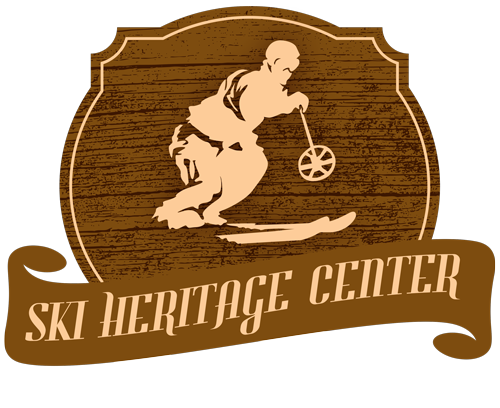They Bet Their Shirts on Skiing #6
By ED SCHENCK, as told to EDMUND CHRISTOPHERSON
(Reprinted from The Saturday Evening Post, March 4, 1950. This is the 6th installment, continued from last week’s Ski Locker feature.)
Lester Scott was the first to realize that the election that fall meant another real reservoir of manpower. He got on the phone and called all the candidates in the county and invited them to labor with us. It was just as mandatory for politicians as an invitation to a church social, and they swarmed in from all corners of the county. We had County Atton1ey Ambrose Measure, County Commissioner Charlie Luke, and dozens more literally working for votes. Some of them even brought their own axes. By the time the road was finished, the Forest Service figured that more than $5000 in work had been contributed by our volunteers.
Before we were through building the road, the fall rains began. Lightning toppled a big snag and sent it crashing uncomfortably close to where George was clearing with the cat. I was rigging towers, and since I hadn't even worn a pair of climbers for fifteen years, shinnying up a forty-foot pole terrified me. All the time we had to keep watching for signs of approaching rainfall, so we could get off the hill before we were hopelessly marooned.
Our water supply for the lodge came from a catchment basin 1400 feet farther up the mountain, and in this distance, there was an eighty-eight-foot drop, which should have sent the water surging into the building. But when we'd laid the four-inch wooden pipe into the lodge, and our plumber, Bill (Snuffy) Reed, connected it up, nothing happened. He scratched his head and commented, "Damnedest thing I ever saw! A four-inch pipe and no water! I quit!" The pipe wasn't covered, and we drilled holes in it to see if the water was getting through. It was, but still no water in the lodge. Suddenly, two weeks later, for no reason we'd figured out, it started working fine. Still, it was temperamental all that first season.
With construction problems out of the way, we found that we'd just traded one set of problems for another. Skiing had no more than started before the ski bums began to drift in. A ski bum, I might explain, is someone so enamored of skiing that he quits his job, and leaves home or school, to devote himself, full time, to the sport. Skiing just gets some people the way alcohol gets others. They approach resort operators and ask for any sort of work in return for room, board, and skiing privileges. We made the mistake of putting the ski shop in charge of a couple of these characters. They were so busy skiing that two inches of dust collected on the counter. Nowadays, when we hire anyone, we ask him first, “Do you ski?" If he does, he doesn't get the job.
Running the lunchroom was. another educational experience. One of our cooks took the job, we later discovered, so her daughter could meet people and learn to ski. Her successor, who'd never been on skis, got really brave one night and decided to try it. She rode up on the lift and sprained an ankle on the way down. She sprained her other ankle walking into the bar, and for weeks she cooked on crutches.
The water pipes were just. hung naked under the floor joists. They kept freezing, and during the coldest weeks, we'd spend days prowling with blow torches, trying to thaw them out. The oil-fired water heater kept exploding, and everyone would high-tail it down to the basement with drawn fire extinguishers. Our light plant kept conking out, and its favorite moment was on ski nights when we had the runs flood lighted. It was just luck that sudden darkness didn't cause any accidents.
That first winter the two-inch larch flooring we'd put in at the suggestion of one of our stockholders shrank phenomenally. I slept in the room under the bar, and by spring the jackpot money that sifted down through the cracks from the slot machines above ran as high as two bucks a day.
Installing a new coin-proof floor was an important part of our postseason celebrations in the lodge that spring. One evening, above the persistent din of the hammering, George shouted, ''What's that racket in the basement?" We rushed down to find the beginning of a major river coursing through the building. Looking outside, we found that the thaw had begun in earnest. Our diversion ditch had washed out and a big part of the runoff was routed toward the lodge. The rest of that night the party shifted from hammers to shovels to keep the stream from wash ing the lodge down off the mountain.
By summer, "volunteering on the hill" had become an important social activity in Whitefish, taking the place of the first winter's meetings, and we had lots of help. There was lots of work to do, too, but during August I took four days off to marry a local girl who'd just finished nurse's training in Seattle. Marguerite still talks about spending her honeymoon clearing brush on the hill.
I'd like to say that there's no truth in the rumor that, even though she had a steady job with Doc Simons, I married her to be sure of an income. I'll admit that there might be some basis for this belief in the amount of money George and I collected that year. We were on the books at $250 a month each, but we ran more than $1600 behind in collecting it and ended up taking it in common stock. Our 1948 cash income amounted to $1400. It was a lot more serious for George because he'd been married right along, and since he and Phyl moved to Whitefish, they've had two kids.
